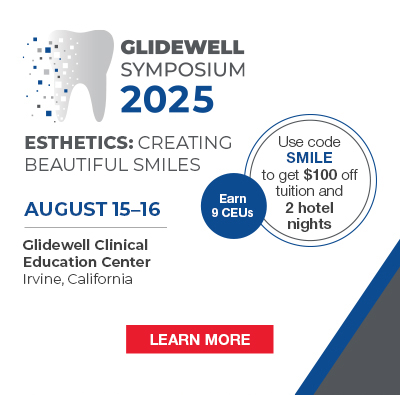Significant research of late has been directed toward the application of computer-aided design/computer-aided manufacturing (CAD/CAM) technology in the fabrication of ceramic restorations. This article presents 2 case reports in which this technology was used to fabricate aesthetic and functional restorations.
 |
 |
 |
|
Figure 1. The CEREC inLab system.
|
Figure 2. The tooth preparation is secured in the scanning platform.
|
Figure 3. Data is captured with a noncontact laser.
|
 Figure 4. A prefabricated VITA block is placed in the milling chamber. Figure 4. A prefabricated VITA block is placed in the milling chamber. |
 Figure 5. Two milling diamonds create the restoration coping to precise specifications. Figure 5. Two milling diamonds create the restoration coping to precise specifications. |
 Figure 6. Restoration coping, postmilling process. Figure 6. Restoration coping, postmilling process. |
TECHNOLOGY AND MATERIALS
 |
 |
 |
|
Figure 7. Various shades of infiltration glass allow the lab technician to sel
ect the ideal match for each use.
|
Figure 8. Porcelain buildup with Vitadur Alpha porcelain. | Figures 9. The end result is an aesthetically pleasing restoration. |
 Figures 10 and 11. Case Report No. 1: Preoperative view. Figures 10 and 11. Case Report No. 1: Preoperative view. |
 |


 |
 |
 |
|
Figures 14 and 15. Cementation with 3M ESPE RelyX ARC.
|
Figure 16. Case Report No. 2: Preoperative view. |
TECHNIQUE
CASE REPORT NO. 1
A 55-year-old woman in good general health presented with a prior composite core on tooth No. 5 that required a crown (Figures 10 and 11). The adjacent tooth (No. 4) had a prior PFM crown that did not present any exposed metal, and the patient requested that no metal be exposed on the crown for tooth No. 5. A CEREC inLab Zirconia crown was chosen, as it would provide high strength while avoiding the use of a metal substructure. Pretreatment photos were taken and shade was determined before initiating treatment. The existing composite resin core was prepared for the all-ceramic crown, with care taken to ensure adequate axial (1.2 to 1.5 mm) and occlusal (2 mm) reduction (Figures 12 and 13). Gingival retraction cord was placed and a final impression using polyvinylsiloxane material was made. A temporary crown was fabricated and cemented before dismissing the patient. Because of the high-strength core of the finished restoration, it may be delivered by using either a conventional cementation technique with a resin-modified glass ionomer cement, or an adhesive cementation technique with a composite resin luting agent. The crown was cemented with RelyX ARC (3M ESPE) (Figures 14 and 15).
 |
 |
| Figure 17. Teeth prepared with chamfer margins. |
Figure 18. Ideal strength is achieved with VITA In-Ceram Zirconia blocks. |


CASE REPORT NO. 2
A 35-year-old woman in good general health presented with multiple missing teeth and defective restorations (Figure 16). After a complete oral examination and treatment plan, a CEREC inLab crown and fixed partial denture were chosen to satisfy the patients aesthetic and functional demands to restore teeth Nos. 11 through 14 as the initial step in rehabilitating her dentition. The mandibular arch was to be restored at a later time per the patients desire to complete her treatment in stages. The teeth were prepared with chamfer margins circumferentially with a minimum of 1.2 mm axial reduction (Figure 17). Final impressions and mounting indexes were made to mount the case on a semi-adjustable articulator. Temporary restorations were delivered and the case sent to the dental laboratory for fabrication. The dies were mounted in the CEREC inLab unit, scanned, and the copings designed on the computer. In-Ceram Zirconia blocks were used to mill the copings to maximize the strength of the restorations (Figure 18). The milled copings were infiltrated and veneered with porcelain to achieve the final contours and aesthetics desired. The final restorations were cemented and the occlusion refined (Figures 19 and 20).
SUMMARY
This article describes 2 clinical cases using technology and materials that give the laboratory technician complete control over the timing, fit, and color of the restoration, while the dentist can rely on the consistent dependability of the technology and the aesthetic quality of the material.
References
Dr. Fasbinder is the director of the Advanced Education in General Dentistry Program and clinical professor in the Department of Cariology, Restorative Sciences and Endodontics, University of Michigan School of Dentistry. His research interests and endeavors have been in the area of applied laboratory and clinical evaluation and development of aesthetic materials and techniques. He also maintains a part-time private practice through the Dental Faculty Associates at the University of Michigan School of Dentistry. He has been involved with research using CAD/CAM technology since 1993. Most recently, Dr. Fasbindes research has focused on clinical applications of the CEREC system. Projects are ongoing to evaluate and document clinical longevity of large adhesive ceramic onlays and inlays. Additional current clinical research projects are aimed at evaluation of newer polymer materials for use with the CEREC system. Dr. Fasbinder can be reached at djfas@ umich.edu.




